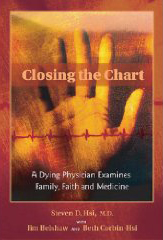Friday morning at Popejoy Hall, his name — Bryan Patterson — was there on the eighth page of the small booklet — “The University of New Mexico School of Medicine Convocation 2009.”
The graduation ceremony took in an array of medical specialties — emergency medical services, medical laboratory sciences, radiologic sciences, dental hygiene, biomedical science, occupational therapy, physical therapy, public health.
His name appeared on the page with those receiving a masters degree in public health. That it was there in the booklet at all sat in my mind like a small wonder, a miracle of some kind. When the graduates began the march from the rear of Popejoy to the seats near the stage, the audience stood and turned to watch them approach.
I had an aisle seat and I could see him when he made the turn into the aisle. When our eyes met, we smiled. By the time he reached me and held out a hand, all we could was laugh. No words came. Only laughter at the disbelieving wonder of it all.
That he could walk was miraculous enough. That he was alive to walk even more so. By rights, by any reasonable medical assessment, Bryan should not have been in the building, should not have been alive, let alone the recipient of a master’s degree in public health.
I first met him in 1996. He lay in a coma in the UNMH intensive care unit, his shattered body host to tubes and IVs and electronic measuring devices sending out a steady stream of information reflecting his terrible condition .
On Halloween night, about a week before, he had walked into a Downtown alley toward his parked car. A gang of 15-20 people described by witnesses as “skinheads†attacked him.
Why? No one knows. Who knows anything about mindless violence?
They beat him with their fists; they kicked his head, repeatedly, until they sheared the brain stem and left him for dead in the alley. At the hospital his family gathered around him — his father, Bob; his mother, Sharon; his brother, David, his then-fiancé, Tyrrell.
The outlook was grim. The doctors didn’t expect him to survive the coma, but after nearly a month, he somehow made his way out of the darkness, made his way back, bursting into semi-consciousness with a loud profanity that sent his father into a delirious joy.
I wrote a column for the Albuquerque Journal back then. His family allowed me into their circle so I might chronicle how a small group of loved ones finds their way through the kind of unspeakable nightmare that began for all of them that Halloween night. He was 29, a scientist, and his life ended that night. Oh, he survived, he lived. But the life he had known came to a sudden end. A new one took its place, and the newness was not bright and shiny.
The brain damage was permanent, despite his miraculous recovery. One of his doctors said he’d never seen anything like it. Nonetheless, the Bryan Patterson who walked down an alley on that Halloween night disappeared forever. The new one would struggle with all the obstacles strewn in the path of the severely brain injured. He had to learn how to speak. He had to learn how to walk. He had to learn how to function in society.
He married, but the marriage didn’t survive the brain injury. The pressures crushed the marriage. Over the years, he secured victories and suffered losses — one step forward, two back, that sort of thing.
Then Friday morning at Popejoy Hall, there he was on the eighth page of a convocation booklet, the holder of a new master’s degree in public health. I sat in the audience watching him climb the stairs to the stage to be hooded by his UNM mentor and I remembered the day he fell down in his kitchen trying to walk no more than six feet.
A string quartet played classical music on the Popejoy stage. Janet Napolitano, the Secretary of the Department of Homeland Security, was the commencement speaker. Like all commencement venues, Popejoy buzzed with the sound of joy, the celebration of achievement, the pomp and circumstance that had dignitaries and scholars in colorful robes on stage; and families whooping and hollering in the audience at the sound of a daughter’s name or the ascendancy of a son to the stage.
I like commencements, regardless of the level of education. I like the happiness in the air. And when I heard Bryan was getting a master’s degree, I had to see it. I wrote columns about him and his family for more than year. They were all there at Popejoy on Friday except for his dad, Bob, a man of wit and intelligence and great spirit. He died last year of a heart ailment. He would have been a deservedly proud man Friday morning.
In school at UNM, Bryan agreed to tests to measure his deficits. It had been many years since he had undergone such tests. The results were not encouraging.
“My short term memory was terrible,†he said. “I had great difficulty multi-tasking. But somehow I dragged myself across the finish line.â€
It took him six years. Friday morning, the finish line came into sight.



Mon 25 May 2009
“The Photographer”
Posted by jimbelshaw under Commentary
Comments Off on “The Photographer”
Chris Hedges has a review in the Times Book Review on a book called “The Photographer.” The review alone will strip any notion of glory from war that you might have entertained.